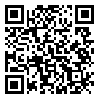Volume 27, Issue 2 (7-2021)
Back to this Issue |
Back to browse issues page
Download citation:
BibTeX | RIS | EndNote | Medlars | ProCite | Reference Manager | RefWorks
Send citation to:



BibTeX | RIS | EndNote | Medlars | ProCite | Reference Manager | RefWorks
Send citation to:
Norouzinia R, Ebadi A, Yarmohammadian M H, Chian S, Aghabarary M. Relationship between resilience and self-efficacy with professional quality of life in EMS personnel. Journal of Hayat 2021; 27 (2) :176-189
URL: http://hayat.tums.ac.ir/article-1-4103-en.html
URL: http://hayat.tums.ac.ir/article-1-4103-en.html
Relationship between resilience and self-efficacy with professional quality of life in EMS personnel
Roohangiz Norouzinia1 

 , Abbas Ebadi2
, Abbas Ebadi2 

 , Mohammad Hosein Yarmohammadian3
, Mohammad Hosein Yarmohammadian3 

 , Saied Chian4
, Saied Chian4 

 , Maryam Aghabarary *
, Maryam Aghabarary * 

 5
5


 , Abbas Ebadi2
, Abbas Ebadi2 

 , Mohammad Hosein Yarmohammadian3
, Mohammad Hosein Yarmohammadian3 

 , Saied Chian4
, Saied Chian4 

 , Maryam Aghabarary *
, Maryam Aghabarary * 

 5
5
1- Dept. of Prehospital Emergencies, School of Nursing, Alborz University of Medical Sciences, Karaj, Iran; Social Determinants of Health Research Center, Alborz University of Medical Sciences, Karaj, Iran
2- Dept. of Management Nursing, School of Nursing, Bagiyatallah University of Medical Sciences, Tehran, Iran; Behavioral Sciences Research Center, Life Style Institute, Baqiyatallah University of Medical Sciences, Tehran, Iran
3- Dept. of Health in Emergencies and Disaster, School of Management and Medical Informatics, Isfahan University of Medical Sciences, Isfahan, Iran; Health Management and Economics Research Center, Isfahan University of Medical Sciences, Isfahan, Iran
4- Dept. of Prehospital Emergencies, School of Nursing, Alborz University of Medical Sciences, Karaj, Iran; Student Research Committee, Alborz University of Medical Sciences, Karaj, Iran
5- Dept. of Nursing, School of Nursing, Alborz University of Medical Sciences, Karaj, Iran; Social Determinants of Health Research Center, Alborz University of Medical Sciences, Karaj, Iran ,aghabararym@gmail.com
2- Dept. of Management Nursing, School of Nursing, Bagiyatallah University of Medical Sciences, Tehran, Iran; Behavioral Sciences Research Center, Life Style Institute, Baqiyatallah University of Medical Sciences, Tehran, Iran
3- Dept. of Health in Emergencies and Disaster, School of Management and Medical Informatics, Isfahan University of Medical Sciences, Isfahan, Iran; Health Management and Economics Research Center, Isfahan University of Medical Sciences, Isfahan, Iran
4- Dept. of Prehospital Emergencies, School of Nursing, Alborz University of Medical Sciences, Karaj, Iran; Student Research Committee, Alborz University of Medical Sciences, Karaj, Iran
5- Dept. of Nursing, School of Nursing, Alborz University of Medical Sciences, Karaj, Iran; Social Determinants of Health Research Center, Alborz University of Medical Sciences, Karaj, Iran ,
Abstract: (4516 Views)
Background & Aim: Pre-hospital emergency staff, as the first responder group at the scene of emergencies and disasters, should be able to cope with, and maintain their physical and mental health. The aim of this study was to investigate the relationship between resilience and self-efficacy of pre-hospital emergency staff with their professional quality of life.
Methods & Materials: The present study is a cross-sectional, descriptive study that was conducted in 2019. A total of 200 pre-hospital emergency operational staff from Alborz province participated in the study using proportional and convenience sampling. Data collection tools were a demographic form and three standardized questionnaires including the emergency medical services resilience scale, the Schwartz and Jerusalem self-efficacy scale, and the Stamm professional quality of life scale. Data were analyzed through the SPSS software version 20 using descriptive statistics (mean and standard deviation) and analytical statistics (Spearman correlation, one-way ANOVA and linear regression) at the significance level of P less than 0.05.
Results: The mean and standard deviation of self-efficacy (29.67±5.82), resilience (123.14±17.07), compassion satisfaction (39.81±8.09), burnout (12.06±4.76), and secondary traumatic stress (23.61±7.27). There was a significant correlation between self-efficacy and three components of professional quality of life (P<0.05). Self-efficacy was positively related to compassion satisfaction and negatively related to burnout and secondary traumatic stress. Self-efficacy and resilience were also predictors of compassion satisfaction and burnout (P<0.05). The effect of self-efficacy and resilience on compassion satisfaction was positive. The results of stepwise multiple linear regression analysis showed that five components of resilience including self-management, stress outcomes, communication challenges, maintaining peace of mind and job motivation had an effect on compassion satisfaction (P<0.05). The effect of all resilience components on compassion satisfaction was positive.
Conclusion: Alborz pre-hospital emergency operational staff were at an acceptable level in terms of resilience, self-efficacy and professional quality of life.
Methods & Materials: The present study is a cross-sectional, descriptive study that was conducted in 2019. A total of 200 pre-hospital emergency operational staff from Alborz province participated in the study using proportional and convenience sampling. Data collection tools were a demographic form and three standardized questionnaires including the emergency medical services resilience scale, the Schwartz and Jerusalem self-efficacy scale, and the Stamm professional quality of life scale. Data were analyzed through the SPSS software version 20 using descriptive statistics (mean and standard deviation) and analytical statistics (Spearman correlation, one-way ANOVA and linear regression) at the significance level of P less than 0.05.
Results: The mean and standard deviation of self-efficacy (29.67±5.82), resilience (123.14±17.07), compassion satisfaction (39.81±8.09), burnout (12.06±4.76), and secondary traumatic stress (23.61±7.27). There was a significant correlation between self-efficacy and three components of professional quality of life (P<0.05). Self-efficacy was positively related to compassion satisfaction and negatively related to burnout and secondary traumatic stress. Self-efficacy and resilience were also predictors of compassion satisfaction and burnout (P<0.05). The effect of self-efficacy and resilience on compassion satisfaction was positive. The results of stepwise multiple linear regression analysis showed that five components of resilience including self-management, stress outcomes, communication challenges, maintaining peace of mind and job motivation had an effect on compassion satisfaction (P<0.05). The effect of all resilience components on compassion satisfaction was positive.
Conclusion: Alborz pre-hospital emergency operational staff were at an acceptable level in terms of resilience, self-efficacy and professional quality of life.
Send email to the article author
| Rights and permissions | |
 |
This work is licensed under a Creative Commons Attribution-NonCommercial 4.0 International License. |



